Introduction
Pigweed, often dismissed as a mere weed, is an overlooked gem with a wealth of benefits. Commonly found in gardens, fields, and along roadsides, pigweed is frequently uprooted and discarded without a second thought. However, this unassuming plant is far more than an agricultural nuisance. With a rich history of use in traditional medicine and modern nutrition, pigweed (Amaranthus spp.) has proven itself to be a remarkable plant with numerous applications. This article will delve into the significance of pigweed, its uses, benefits, and how you can make the most of this versatile plant.
The Importance of Pigweed
Pigweed is a member of the Amaranthaceae family, which includes several species renowned for their nutritional and medicinal properties. Despite its reputation as a weed, pigweed offers substantial advantages that can enrich both your diet and garden. Here’s why this plant is worth your attention:
- Nutritional Value: Pigweed is a powerhouse of nutrients. Its leaves and seeds are packed with vitamins, minerals, and antioxidants, making it a valuable addition to any diet.
- Soil Enrichment: The plant contributes to soil health by adding organic matter and enhancing soil structure.
- Traditional Medicine: Pigweed has been used in various cultures for its medicinal properties, including anti-inflammatory and diuretic effects.
- Sustainability: Its ability to thrive in various conditions makes it a sustainable and resilient plant choice for diverse environments.
Identifying Pigweed
Before you can reap the benefits of pigweed, it’s essential to be able to identify it correctly. Here are key characteristics to look for:
- Leaves: Pigweed leaves are typically green, with a smooth or slightly serrated edge. They are often diamond-shaped or ovate.
- Flowers: The plant produces small, greenish or reddish flowers in dense clusters at the tips of the stems.
- Seeds: Pigweed’s seeds are tiny, grain-like, and often found in clusters. They can be brown, black, or reddish.
- Growth Habit: The plant can grow up to 4 feet tall, with a branching habit. It thrives in disturbed soils and can be found in gardens, fields, and along roadsides.
Harvesting Pigweed
To make the most of pigweed, proper harvesting techniques are essential. Here’s how to collect and prepare this valuable plant:
- Timing: Harvest pigweed when the leaves are young and tender for the best flavor and nutritional value. The seeds can be collected when they are mature and dry.
- Picking Leaves: Use clean scissors or pruning shears to cut the leaves from the plant. Choose healthy, undamaged leaves.
- Collecting Seeds: Wait until the seeds are fully mature and dry. Gently shake or rub the seed heads to release the seeds, then sift through to remove any debris.
Preparing Pigweed for Consumption
Pigweed can be enjoyed in various culinary applications. Here’s how to prepare it:
- Cleaning: Rinse the leaves thoroughly under cool running water to remove any dirt or insects. Soak them briefly if needed.
- Cooking: Pigweed leaves can be sautéed, steamed, or added to soups and stews. Cooking reduces the plant’s oxalate content, making it easier to digest.
- Raw Consumption: Add young, tender leaves to salads for a nutritious and flavorful addition. Ensure the leaves are free from any pesticides or contaminants.
- Seed Use: Pigweed seeds, also known as amaranth seeds, can be cooked like grains or used as a topping for dishes. They are rich in protein and can be used in baking or as a breakfast cereal.
Benefits of Pigweed
Pigweed’s nutritional and health benefits make it a valuable plant. Here’s a closer look at its advantages:
- Nutrient-Rich: Pigweed is high in vitamins A and C, calcium, iron, and magnesium. It also provides a good source of dietary fiber and protein.
- Antioxidants: The plant contains antioxidants that help combat oxidative stress and reduce inflammation.
- Medicinal Properties: Traditionally, pigweed has been used to treat various ailments, including digestive issues, kidney problems, and skin conditions.
- Soil Enrichment: When used as green manure or compost, pigweed enhances soil fertility by adding organic matter and improving soil structure.
Utilizing Pigweed in Your Garden
Incorporating pigweed into your garden can have several benefits:
- Cover Crop: Grow pigweed as a cover crop to improve soil health and prevent erosion. Its rapid growth helps to suppress weeds and add organic matter to the soil.
- Companion Planting: Use pigweed as a companion plant to support the growth of other vegetables and flowers. Its deep roots can help break up compacted soil and improve aeration.
- Natural Pest Control: The plant’s robust growth and dense foliage can provide habitat for beneficial insects that help control garden pests.
Recipes and Uses
Here are a few ways to incorporate pigweed into your diet:
- Pigweed Salad: Combine fresh pigweed leaves with other salad greens, cherry tomatoes, cucumbers, and a light vinaigrette.
- Sautéed Pigweed: Sauté pigweed leaves with garlic and olive oil for a nutritious side dish.
- Pigweed Soup: Add pigweed leaves to vegetable soup for an extra boost of nutrients.
- Amaranth Seed Porridge: Cook pigweed seeds with milk and honey for a nutritious breakfast porridge.
Conclusion
Pigweed may be an unassuming plant, but its benefits are far from ordinary. From its impressive nutritional profile to its role in soil enrichment and traditional medicine, pigweed is a plant that deserves more attention. By learning to identify, harvest, and prepare pigweed, you can enhance your diet, garden, and overall well-being. Don’t overlook this common plant—embrace its potential and discover how pigweed can become a valuable asset in your gardening and culinary endeavors. So next time you encounter pigweed, remember its hidden value and make the most of this remarkable plant!

